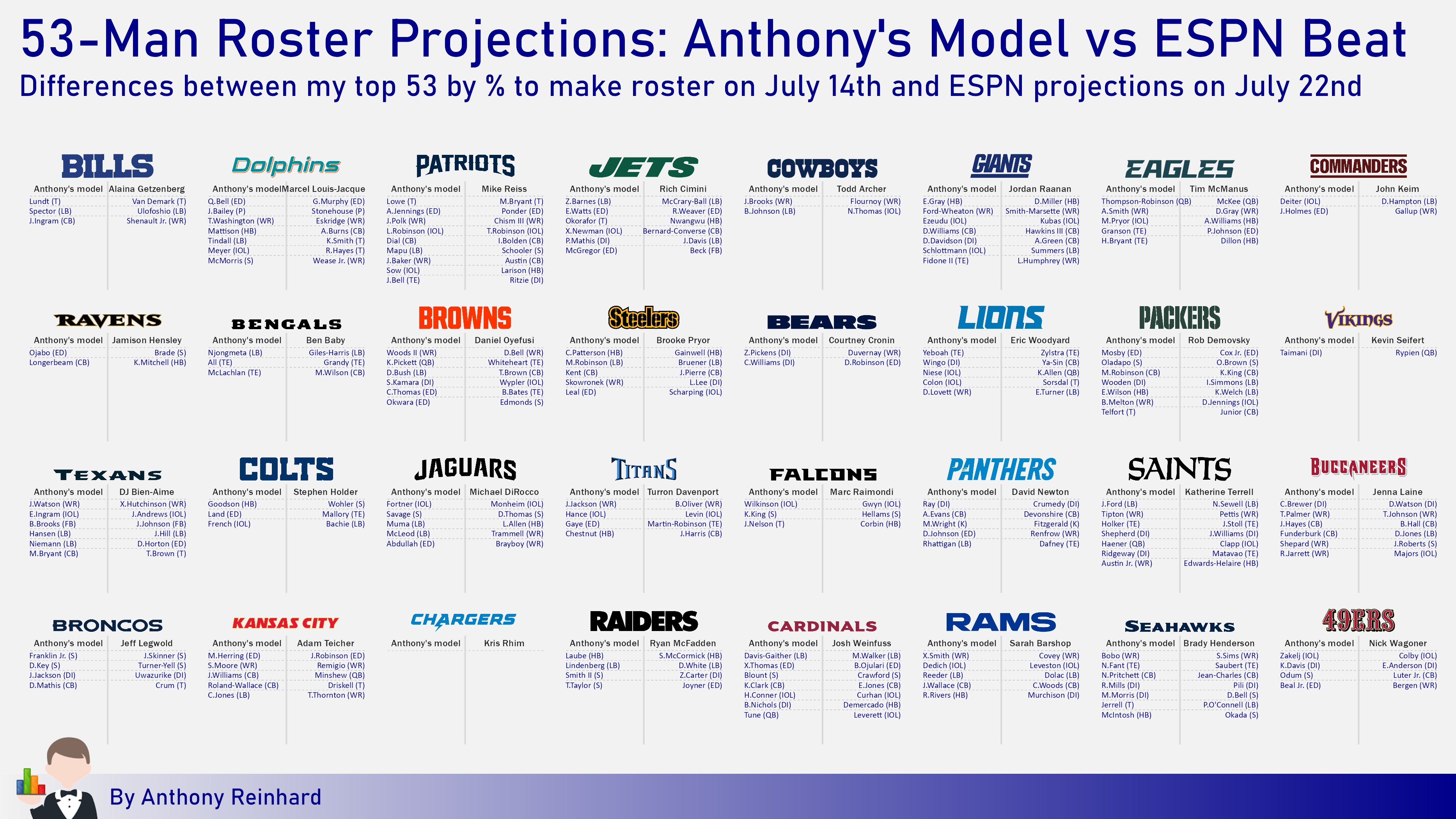32 53s: Anthony vs ESPN
I compare my pre-training camp 53-man roster projections to ESPN's 32 NFL Nation writers
Recently, I shared the output of my model projecting 53-man rosters. The rollout has been smoother than I’d expected to be honest. I’ve already picked up on a few oversights and blind spots in the model thanks to well-informed readers, but overall, I think the model passes the smell test in 95% of cases. This week, I was presented with an opportunity to see how my model stacks up with the experts at ESPN.
With training camp beginning in earnest this week, the worldwide leader in sports dispatched their crew of 32 NFL Nation writers to come up with their own 53-man projections for every team. Below, I’ve broken down 147 slots where my model’s top 53 disagreed with the ESPN beat writers.
There were many cases where the ESPN projection excluded players injured players who are likely to start the season on the Physically Unable to Perform (PUP) list. In the cases where a PUP stint was explicitly mentioned, I removed that player from my top 53 projection and instead added my 54th highest probability player. In a few cases there were transactions that occurred between my last model run on July 14th and ESPN’s publishing on July 22nd. If ESPN included a player in their projection who was signed over that period (like Von Miller with the Commanders), I’m only comparing my model to their other 52 picks.
I was excited to see that there were some teams I really did well with. I called out the Chargers specifically in my AFC West prediction post as a team that had a lot of players on the extremes. After the removal of Mike Williams from my top 53 due to his retirement, I was perfectly aligned with the roster projection of Kris Rhim. I also lined up very well with Kevin Seifert on the Vikings beat. His only deviation from my top 53 was the inclusion of QB3 Brett Rypien (who I had 54th) over DT Taki Taimani (who I had 51st). I was within two slots of matching with four other teams: BAL, DAL, CHI, and WAS.
The projection with the most significant deviation from my own was Mike Reiss of the Patriots. His projection had nine slots different from my top 53. Eight of those nine players that Mike profiled as cuts were former draft picks, including five from the Pats 2024 class. To replace those players, he selected four UDFAs that I categorized as longshots. While many UDFAs across the league will ultimately make rosters, it is difficult to zero in on who will break through. Only one other ESPN projection (TB) selected multiple UDFAs. My model had only two UDFAs crack any of my top 53s: Texans LS Austin Brinkman and Buccaneers OT Ben Chukwuma.
Turning to individual players, I’m expecting players in my “lock” category to make rosters 99.5% of the time and I had 910 players in that category. The ESPN writers collectively picked 9 of these players to fail to make their initial roster. While I stand by most of them, I’m sad to report that 49ers special teamer George Odum has already been released and his reported injury will likely prevent him from signing with another team until midseason. In this case, I was relying too heavily on the fact that Odum reportedly had $1m vest into a guarantee in April. In hindsight, that number probably isn’t enough to clinch a roster spot, especially for a special teamer.
On the other end of the spectrum, my biggest disagreement on a player included in ESPN’s projections is Texans C Jake Andrews. Andrews spent all of 2024 on injured reserve with New England and was claimed on waivers this April. Both of those facts hurt him heavily in my model. After a strong minicamp, there appears to some optimism about his chances. The player I’ve received the most feedback on is Eagles QB Tanner McKee. I pegged McKee as a “dark horse” (15% to 35%) in my model based on the fact that he was a healthy scratch for 15 games last season as the third QB. It appears he is now a favorite to land the backup job over Dorian Thompson-Robinson, who was acquired when the Eagles sent 2024 backup Kenny Pickett to Cleveland, and 6th round draft pick Kyle McCord.
I’m not expecting my model to outperform full-time reporters when it’s all said and done, but simply making the comparison gives me a chance to explore new ways to improve my model. Regardless, I’m excited to see how our respective predictions develop.
Thanks for reading!



